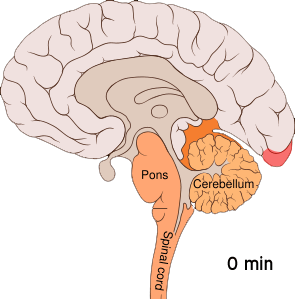20 September, 2019
Migraines
Approximate reading time: 3 - 4 minutes
Migraines are a common neurological condition affecting almost a quarter of Australian households.
There are many different migraine symptoms:
Headache
Nausea / vomiting
Dizziness / unsteadiness / vertigo
Motion sensitivity
Light sensitivity
Noise sensitivity
Visual changes such as lines or blobs in vision
Tingling or numbness
Migraines are not just a bad headache. Headache is one of many symptoms of a migraine. Some people suffer severe headaches that are not migraines. Others suffer from migraines without any headaches.
Healthcare providers will make a diagnosis after asking a lot of questions. Sometimes they'll get an MRI done but most of the time it's not needed.
After being accurately diagnosed, you can then get the most appropriate treatment.
Migraines are also complicated by the overlapping conditions like
Anxiety and depression
Heart disease and high blood pressure
Stroke
Restless leg syndrome
Types of migraines
Some examples of migraines are:
Migraine with aura
Migraine without aura
Vestibular migraine
Menstrual migraine
Chronic migraine
Episodic migraine
Secondary migraine
Hemiplegic migraine
Retinal migraine
What causes migraines?
Migraines are complex! Many factors contribute:
Neurological (brain & nerves)
Vascular (arteries & veins)
Chemical (hormones & neurotransmitters)
Immunological
This is why so many migraineurs settle for less frequent and less debilitating migraines, rather than expecting to find a cure.
Migraine sufferers have sensory hypersensitivity. Their brain has an exaggerated response to small sensations. Seemingly inconsequential triggers get a big reaction! LIke flickering lights causing a migraine attack.
Scientists believe that the brain goes quiet. Generally starting in the visual or touch areas of the brain. This then spreads to other brain areas like a ripple in a lake. This is called cortical spreading depression. 'Depression' is not referring to feeling down but the decrease in electrical activity in the brain.
This decreased brain activity is believed to cause the aura symptoms such as visual changes, weakness and tingling experienced by 30% of migraine sufferers. This dumps lots of chemicals in the brain. These chemicals activate the pain fibres around the head. That's how the headache comes about.
Interestingly, this is a similar mechanism to concussions (Seifert 2018). There's more similarities. Both have similar symptoms, both more prevalent in females and both can be exacerbated by hormones.
Research also shows changes in the brain chemical messengers - called neurotransmitters. Dopamine levels drop during a migraine attack. It passes messages on between nerves. Dopamine is the ‘feel good’ neurotransmitter which helps regulate emotion, motivation & sensory perception.
And then there's there's the good old theory - vascular changes. This was first talked about in the second century (Mason & Russo 2018)! The arteries around the head get bigger giving the pulsating headache. These blood vessels then release more pro-inflammatory chemicals.
Yep - migraines are complex. Researchers are still debating the true cause of migraines. Studies continue to be done every year with new findings.
What treatments options are available?
A comprehensive approach is often required. The different causes need to be addressed: nervous system sensitivity, chemical imbalances, blood vessel changes and immune system activation.
Just like Goldilocks, it is important to have not only the right treatment but the right amount of treatment. Too much can trigger a migraine and not enough can slow progress.
After GPs, pharmacists and dentists, Chiropractors are the most frequently sought after health practitioners for migraines. Many migraineurs respond well to manual treatments such as spinal adjustments, massage and home rehabilitation exercises.
You may benefit from a holistic approach to migraines such as addressing:
Joint and muscle restrictions and tightness in the neck, shoulders, jaw and upper back
Poor posture and faulty movement patterns
Over-responsive nervous systems
Identifying and eliminating triggers
Calming down the immune system
Cleaning up the chemical "dump"
Reducing inflammation
We believe in a team approach
We know that migraines are complicated. That's why we work together to get you the best results.
Some people work with us alongside their GPs, neurologists or pain management specialists while others don't require medication.
Our team members who can help you:
Appointments available in Moonee Ponds or online.
About the Author

Dr Cassie Atkinson-Quinton - Chiropractor, Brain Health Coach & Biofeedback Practitioner
Dr Cassie is a Chiropractor and Brain Health Coach. Having a special interest in treating nerves and brain-based conditions like nerve pain, chronic pain, dizziness, whiplash, migraines and fibromyalgia. She's one of a handful of practitioners to be trained in Neuro-Rehabilitation, Neurofeedback, QEEG Functional Brain Scans and Brain Health Coaching. She’s had concussions and atypical migraines as well as a vestibular disorder called Labyrinthitis. During this time, she would hold on to tables to avoid falling over. She understands the journey coming from a family of chronic pain and migraine sufferers.
Similar articles you'll enjoy:
Back to Blog
Fong CY, Law WHC, Braithwaite JJ & Mazaheri A (2020). Differences in early and late pattern-onset visual-evoked potentials between self- reported migraineurs and controls. NeuroImage: Clinical, 2020; 25: 102122 DOI: 10.1016/j.nicl.2019.102122
DaSilva AF, Nascimento DT, Jassar H, Heffernan J, Toback RL, Lucas S, DosSantos MF, Bellile EL, Boonstra PS, Taylor JMG, Casey KL, Koeppe RA, Smith YR & Zubieta JK (2012). Dopamine D2/D3 imbalance during migraine attack and allodynia in vivo. Neurology, 2017; 10.1212/WNL.0000000000003861 DOI: 10.1212/WNL.0000000000003861
Goadsby PJ(2012). Pathophysiology of migraine. Ann Indian Acad Neurol. 2012 Aug; 15(Suppl 1): S15–S22. Doi: 10.4103/0972-2327.99993
Mason BN & Russo AF (2018). Vascular Contributions to Migraine: Time to Revisit? Front. Cell. Neurosci., 03 August 2018 |https://doi.org/10.3389/fncel.2018.00233
Oh K, Cho SJ, Chung YK, Kim JM &Chu MK (2014). Combination of anxiety and depression is associated with an increased headache frequency in migraineurs: a population-based study. BMC Neurol. 2014; 14: 238.Published online 2014 Dec 14. Doi: 10.1186/s12883-014-0238-4
Seifert T (2018). The relationship of migraine and other headache disorders to concussion. Handb Clin Neurol. 2018;158:119-126. doi: 10.1016/B978-0-444-63954-7.00012-4.
Wang SJ, Chen PK and Fuh JL (2010). Comorbidities of Migraine. Front Neurol. 2010; 1: 16.Published online 2010 Aug 23. Prepublished online 2010 Apr 29. doi: 10.3389/fneur.2010.00016







